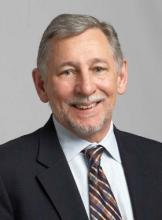LAS VEGAS – Nearly 45% of children and adolescents admitted as inpatients to a psychiatric hospital were prescribed antipsychotics over a 10-year period.
The top five variables significantly associated with use of antipsychotics were a diagnosis of psychosis (odds ratio, 7.2), taking anticonvulsants (OR, 2.7), taking lithium (OR, 2.5), having posttraumatic stress disorder (PTSD; OR, 2.3), and taking benzodiazepines (OR, 2.0).
Those are key findings from a single-center study that set out to examine antipsychotic prescribing practices for patients under age 18 between 2000 and 2010. The study, thought to be the largest of its kind, was undertaken at the Hartford, Conn.–based Institute of Living, part of Hartford Hospital.
"This is an important issue because these antipsychotic medications are commonly prescribed," Dr. John W. Goethe said at a psychopharmacology conference sponsored by the Nevada Psychiatric Association. The amount of published data about antipsychotic use in children and adolescents who are inpatients is scant, he said. Most of the literature has focused on outpatients.
In addition, Dr. Goethe said, antipsychotics are commonly used for indications that have not been approved by the Food and Drug Administration. The clinical rationale for this type of use is not well understood
Dr. Goethe, director of the Burlingame Center for Psychiatric Research and Education at the Institute of Living, went on to note that outpatient visit rates for second-generation antipsychotics quadrupled between 1997 and 2002. As a result, he said, concern has been rising about the metabolic syndrome side effects of the second-generation antipsychotics, and about the cardiovascular and hepatic effects of these drugs. Prolonged elevations of prolactin also have occurred as a side effect of some of these drugs. The literature documenting concern about the use of these drugs in children and adolescents is extensive, he said.
Using a computerized clinical evaluation and monitoring system that has been employed at the institute since 2000, Dr. Goethe and his associates analyzed antipsychotic prescribing practices in 3,851 consecutive inpatient admissions of children and adolescents aged 5-17 years. They also examined a subsample of 2,816 patients for whom antipsychotic dose at discharge was available. In addition, they examined two subsamples to determine changes in prescribing patterns over time: a group of 1,422 patients between 2000 and 2003, and a group of 2,120 patients between 2006 and 2010. Data collected included age, gender, race/ethnicity, clinical diagnosis, antipsychotic type at discharge, antipsychotic dose at discharge, use of other psychotropic medications at discharge, and length of stay.
The mean age of the 3,851 patients was 14 years. Of these, 74% were adolescents aged 13-17 years, and 26% were children aged 5-12 years. A slightly higher proportion of the patients was girls (51%). However, there were significantly more boys than girls among the 5- to 12-year-olds (67% vs. 33%, respectively), and significantly more girls than boys among the 13- to 17-year-olds (58% vs. 42%).
More than half of all the patients (56%) were white, 24% were Latino, 12% were black, and the remaining 8% were from other ethnic groups.
By diagnostic category, 40.7% had psychosis, 20.7% had behavioral disorders, 17.7% had mood disorders, 17% had PTSD, 2.9% had other anxiety disorders, and 0.9% had other disorders.
Dr. Goethe reported that the prevalence of antipsychotic use was 44% overall, and was higher among children than adolescents (52% vs. 42%, respectively). The top five antipsychotics used and the mean dosing at discharge were aripiprazole (11.8 mg), quetiapine (205.9 mg), risperidone (1.5 mg), chlorpromazine (146.1 mg), and ziprasidone (82.1 mg).
Second-generation antipsychotics (SGAs) were prescribed in 94.1% of cases. Of those prescribed SGAs, 3.6% of the overall sample of children and adolescents also received first-generation antipsychotics (FGAs). However, the use of FGAs in children was 7.5%. "We were surprised at this finding but could not determine from the data a reason for this difference," Dr. Goethe said in a later interview.
By diagnostic category, 77% of patients with a psychosis diagnosis received an antipsychotic, compared with 46% of those with PTSD, 45% of those with a behavioral disorder, 31% of those with other anxiety disorders, 24% of those who had a mood disorder without psychosis, and 20% who had other disorders.
Among the 1,707 patients who received an antipsychotic, the four most commonly coprescribed psychotropic agents were antidepressants (58%), anticonvulsants (31%), lithium (8%), and benzodiazepines (7%).
Hospital length of stay was significantly longer for children and adolescents who received antipsychotics than for those who did not: 19 vs. 11 days, respectively, in those with psychosis; 14 vs. 7 days in those with a mood disorder without psychosis; 20 vs. 8 days in those with a behavioral disorder; and 22 vs. 10 days among those with PTSD.


